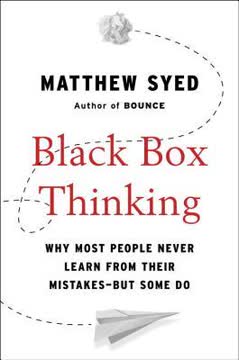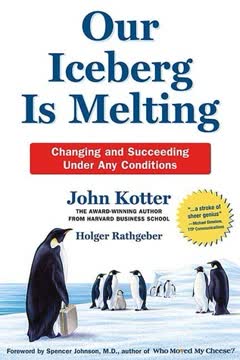Key Takeaways
1. Challenge Your Assumed Constraints to Unlock Your Potential
An assumed constraint is a belief that limits your experience.
Elephant thinking limits potential. Just as a chained baby elephant grows up believing it can't break free, people often hold onto limiting beliefs that prevent them from reaching their full potential. These assumed constraints can be personal, professional, or situational, and they often stem from past experiences or false perceptions.
Challenging assumptions opens doors. By questioning these limiting beliefs, individuals can discover new possibilities and overcome obstacles. This process involves:
- Identifying assumed constraints
- Questioning their validity
- Seeking evidence to disprove them
- Reframing beliefs in a more empowering way
Practical application is key. Steve, the protagonist, learns to challenge his assumptions about his abilities, his team's capabilities, and his client's expectations. This shift in mindset allows him to approach problems with fresh perspectives and find innovative solutions.
2. Activate Your Points of Power to Achieve Success
There are five points of power: knowledge, personal, relationship, task, and position.
Recognize your strengths. Understanding and leveraging your points of power is crucial for self-leadership and success. These power sources include:
- Knowledge power: Expertise and skills
- Personal power: Charisma and interpersonal skills
- Relationship power: Network and connections
- Task power: Ability to accomplish specific tasks
- Position power: Authority from organizational role
Leverage diverse power sources. By identifying and activating these various points of power, individuals can enhance their effectiveness and influence. Steve learns to tap into his task power for budgeting and scheduling, while also recognizing the need to develop his knowledge power in client relations and strategy development.
Cultivate and expand power. Actively working to strengthen each point of power can lead to increased success and career growth. This involves continuous learning, relationship building, and taking on challenging tasks to expand one's capabilities.
3. Be Proactive in Getting What You Need to Succeed
The Third Trick of Self Leadership: BE PROACTIVE! GET WHAT YOU NEED TO SUCCEED!
Take initiative for your success. Being proactive means actively seeking out the resources, support, and opportunities necessary for achieving your goals. This approach shifts the responsibility for success from others onto oneself.
Identify and communicate needs. Self-leaders must:
- Assess what they require to succeed
- Clearly articulate these needs to relevant parties
- Seek out appropriate sources of support and guidance
Overcome barriers to asking. Many people hesitate to ask for what they need due to fear of rejection or appearing incompetent. Steve learns to overcome these barriers by framing his requests in terms of what he needs to succeed, rather than asking permission or validation.
4. Understand the Development Continuum to Master New Skills
The Development Continuum captures what people typically experience, so you can be better prepared to handle what will probably happen.
Recognize the learning stages. The Development Continuum outlines four stages individuals typically go through when learning new skills or taking on new challenges:
- D1: Enthusiastic Beginner (low competence, high commitment)
- D2: Disillusioned Learner (low to some competence, low commitment)
- D3: Capable but Cautious Performer (moderate to high competence, variable commitment)
- D4: Self-Reliant Achiever (high competence, high commitment)
Navigate the learning curve. Understanding these stages helps individuals:
- Anticipate and prepare for challenges
- Recognize that setbacks and discouragement are normal parts of the learning process
- Persist through difficulties to reach mastery
Apply to various goals. Steve applies this model to both his professional development and personal goals, such as learning a magic trick, which helps him understand and manage his progress more effectively.
5. Diagnose Your Development Level to Determine Needed Support
When your competence is low, you need direction; when your commitment is low, you need support.
Self-assessment is crucial. Accurately diagnosing your development level on specific tasks or goals allows you to identify the type of support and guidance you need to progress.
Match leadership style to development level. The SLII® Model outlines four leadership styles corresponding to each development level:
- S1: Directing (for D1)
- S2: Coaching (for D2)
- S3: Supporting (for D3)
- S4: Delegating (for D4)
Seek appropriate support. By understanding your development level, you can proactively seek the right kind of support:
- D1 and D2 levels require more direction and guidance
- D3 and D4 levels benefit from increased autonomy and support
Steve learns to diagnose his development level on various aspects of his job, allowing him to seek appropriate support and direction from his boss and colleagues.
6. Embrace the Power of "I Need" to Get Cooperation
The two most powerful words to get what you need to succeed are, "I NEED."
Direct communication is effective. Using the phrase "I need" when making requests is more powerful and effective than asking questions or making indirect statements. This approach:
- Clearly communicates your requirements
- Shows you've thought about what's necessary for success
- Appeals to others' desire to be helpful
Avoid dumb questions. Instead of asking potentially obvious or unhelpful questions, state your needs directly. For example:
- Instead of: "Are you busy?"
- Say: "I need 15 minutes of your time to discuss this project."
Practice assertive communication. Steve learns to apply this technique in various situations, from requesting feedback to managing client relationships, resulting in more productive interactions and better outcomes.
7. Leaders Are Those Who Provide Direction and Support
A leader is anyone who can give you the support and direction you need to achieve your goal.
Expand your definition of leadership. Leadership is not limited to those in formal positions of authority. Anyone who can provide the necessary guidance and support to help you achieve your goals can be considered a leader in that context.
Seek diverse sources of leadership. Recognize that different people can provide leadership in various areas:
- Colleagues with specific expertise
- Mentors outside your organization
- Team members with complementary skills
Be a leader for others. As you develop competence in certain areas, you can become a leader for others by providing the direction and support they need to succeed.
Steve learns to see leadership as a dynamic process, seeking guidance from various sources and eventually becoming a leader for others in his organization.
8. Empowerment Requires Self-Leadership to Be Effective
Empowerment is something someone gives you. Self leadership is what you do to make it work.
Empowerment is not enough. Simply being given authority or responsibility doesn't guarantee success. Effective empowerment requires individuals to take an active role in their own development and success.
Develop self-leadership skills. To make empowerment work, individuals must:
- Take initiative and responsibility for their actions
- Seek out necessary resources and support
- Continuously develop their skills and knowledge
- Adapt to changing circumstances and challenges
Balance autonomy and support. Successful self-leaders know when to act independently and when to seek guidance. Steve learns to balance his newfound autonomy with proactively seeking support when needed, leading to greater success in his role.
By mastering these key takeaways, individuals can become more effective self-leaders, better equipped to handle challenges, and more successful in their personal and professional lives.
Last updated:
Review Summary
Self Leadership and the One Minute Manager receives generally positive reviews, with an average rating of 4.26/5. Readers appreciate its storytelling approach and practical leadership lessons. Many find the book's three main principles of self-leadership valuable: challenging assumed constraints, activating points of power, and being proactive. The book's quick-read format and relatable narrative make complex concepts accessible. Some critics, however, find the parable style less engaging and prefer a more straightforward presentation of ideas. Overall, readers consider it a useful resource for developing self-leadership skills.
Similar Books










Download PDF
Download EPUB
.epub digital book format is ideal for reading ebooks on phones, tablets, and e-readers.














